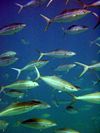Portal:Biology
2008/9 Schools Wikipedia Selection. Related subjects: Biology; Portals; Science
Blue has been chosen as the colour for this portal to emphasise that life on Earth relies on the unique chemistry of water. A photo of Darlingtonia californica, the cobra lily, was chosen as the portal icon because of this species' dependency on a humid habitat, as well as illustrating both autotrophy (in this case, photosynthesis) and carnivory. Finally, it superficially resembles young shoots, with their tips curved in, symbolising growth, a feature of all life.
A prion (IPA: /ˈpriːɒn/ listen) — combination of the first two syllables of the words proteinaceous and infectious (-on by analogy to virion) — is a poorly-understood hypothetical infectious agent that, according to one hypothesis, is composed entirely of proteins. Prions are thought to cause a number of diseases in a variety of mammals, including bovine spongiform encephalopathy (BSE, also known as "mad cow disease") in cattle and Creutzfeldt-Jakob disease (CJD) in humans. All hypothesized prion diseases affect the structure of the brain or other neural tissue, and all are currently untreatable and are always fatal. In general usage, prion can refer to both the theoretical unit of infection or the specific protein (e.g. PrP) that is thought to be the infective agent, whether or not it is in an infective state.
Prions are hypothesized to infect and propagate by refolding abnormally into a structure which is able to convert normal molecules of the protein into the abnormally structured form. All known prions induce the formation of an amyloid fold, in which the protein polymerises into an aggregate consisting of tightly packed beta sheets. This altered structure is extremely stable and accumulates in infected tissue, causing cell death and tissue damage. This stability means that prions are resistant to denaturation by chemical and physical agents, making disposal and containment of these particles difficult.
Proteins showing prion-type behaviour are also found in some fungi and this has been quite important in helping to understand mammalian prions. However, fungal prions do not appear to cause disease in their hosts and may even confer an evolutionary advantage through a form of protein-based inheritance.
Louis Pasteur (27 December 1822 – 28 September 1895) was a French chemist and microbiologist best known for his remarkable breakthroughs in the causes and prevention of disease. His experiments supported the germ theory of disease, also reducing mortality from puerperal fever (childbed), and he created the first vaccine for rabies. He was best known to the general public for inventing a method to stop milk and wine from causing sickness - this process came to be called pasteurization. He is regarded as one of the three main founders of microbiology, together with Ferdinand Cohn and Robert Koch. He is also credited with dispelling the theory of spontaneous generation with his experiment employing chicken broth and a goose neck flask. He also made many discoveries in the field of chemistry, most notably the asymmetry of crystals. He is buried beneath the Institut Pasteur, an incredibly rare honour in France, where being buried in a cemetery is mandatory save for the fewer than 300 "Great Men" who are entombed in the Panthéon.
|
|
- ...that a prokaryotic cytoskeleton has been found in prokaryote organisms by recent advances in visualization technology?
- ...that the Champawat tigress and the Tsavo lions had suffered injuries that disabled them from pursuing their natural prey, leading them to become man-eaters?
- ...that the aphid Brevicoryne brassicae has been called a "walking mustard oil bomb" due to its use of glucosinolates as a chemical defense mechanism against predators?
- ...that the 1984 Rajneeshee bioterror attack was the first bioterrorism attack in the United States, and one of only two confirmed terrorist uses of biological weapons to harm humans?
- ...that Florida has over 20 official state symbols, including a state soil and a state wildflower?
- ...that Adenovirus serotype 14 is an emerging virus, related to the common cold, that has recently caused 10 deaths in the United States, including at least one healthy young adult?
- ...that three out of every seventy-seven rainbow runners (pictured) have five spines rather than the normal six?




